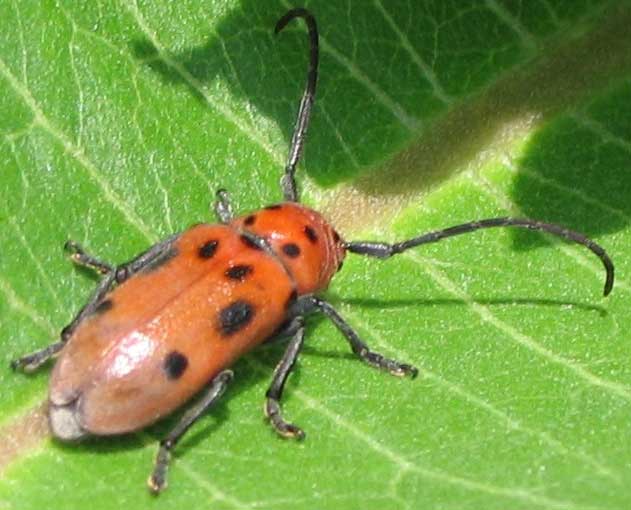
Tetraopes tetrophthalmus (Source)
Superregnum: Eukaryota
Cladus: Unikonta
Cladus: Opisthokonta
Cladus: Holozoa
Regnum: Animalia
Subregnum: Eumetazoa
Cladus: Bilateria
Cladus: Nephrozoa
Cladus: Protostomia
Cladus: Ecdysozoa
Cladus: Panarthropoda
Phylum: Arthropoda
Subphylum: Hexapoda
Classis: Insecta
Cladus: Dicondylia
Subclassis: Pterygota
Cladus: Metapterygota
Infraclassis: Neoptera
Cladus: Eumetabola
Cladus: Endopterygota
Superordo: Coleopterida
Ordo: Coleoptera
Subordo: Polyphaga
Infraordo: Cucujiformia
Cladus: Phytophaga
Superfamilia: Chrysomeloidea
Familia: Cerambycidae
Subfamilia: Lamiinae
Tribus: Tetraopini
Genus: Tetraopes
Species: Tetraopes tetrophthalmus
Name
Tetraopes tetrophthalmus (Forster, 1771)
References
Red Milkweed Beetle
Zoological Institute of Russian Academy of Sciences: Teraopes tetraophthalmus. Lincoln Park, Chicago, Illinois USA
Vernacular names
English: Red milkweed beetle
The red milkweed beetle (Tetraopes tetrophthalmus) is a beetle in the family Cerambycidae.
Explanation of Names
The binomial genus and species names are both derived from the Ancient Greek for "four eyes." As in many longhorn beetles, the antennae are situated very near the eye–in the red milkweed beetle, this adaptation has been carried to an extreme: the antennal base actually bisects the eye (See Fig. 1).
Host Plant
The milkweed beetle, a herbivore, is given this name because they are generally host specific to milkweed and dogbane plants (family Apocynaceae).
Toxicity
It is thought the beetle, which as an adult feeds on the foliage of the plant, and its early instars, which eat the roots,[1] derive a measure of protection from predators by incorporating toxins from the plant into their bodies, thereby becoming distasteful, much as the monarch butterfly and its larvae do.
Behavior
These beetles feed by opening veins in the milkweed plant, decreasing the beetles' exposure to latex-like sap. [2] When startled, the beetles make a shrill noise. When interacting with another beetle, they make a 'purring' noise. [3] The red and black coloring are aposematic, advertising the beetles' inedibility. There are many milkweed-eating species of insect that use the toxins contained in the plant as a chemical defense. Red milkweed beetles lay egg-clutches in mid-summer near the roots of the milkweed.
References
Erwin, Alex; Zust, Tobias; Ali, Jared (19 March 2014). "Above-ground herbivory by red milkweed beetles facilitates above- and below-ground conspecific insects and reduces fruit production in common milkweed". Journal of Ecology. 104 (4). doi:10.1111/1365-2745.12248. Retrieved 1 July 2020.
"Tetraopes tetraphthalmus: the Milkweed Dweller". HomeClassificationHabitat Form. Retrieved 1 July 2020.
"Form and Function". HomeClassificationHabitat Form. Retrieved 1 July 2020.
Retrieved from "http://en.wikipedia.org/"
All text is available under the terms of the GNU Free Documentation License

